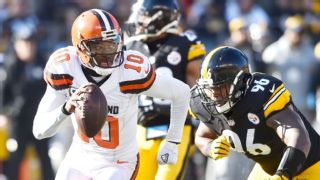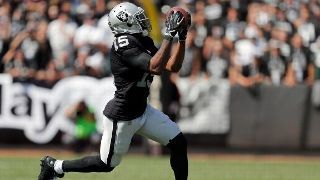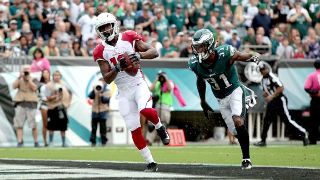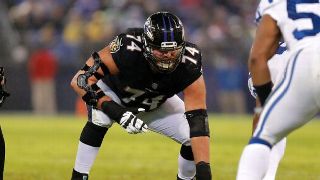|
Here is a breakdown of the Baltimore Ravens' 2018 free-agent signings: Robert Griffin III, WRThe Ravens signed quarterback Robert Griffin III, who previously played for the Washington Redskins and Cleveland Browns before being out of the league last season. Here’s a closer look at the signing: Grade: C. This gets graded on a curve. The Ravens didn't have the cap room to sign an above-average backup, and most of the bargain options weren't appealing. If Baltimore didn't sign Griffin, the other choices were Mark Sanchez, Derek Anderson and T.J. Yates. The Ravens could have done better by signing Colin Kaepernick, but the national anthem protests have played a part in increasing no-shows at M&T Bank Stadium. Griffin, who actually has a better career passer rating than Joe Flacco's, was the less polarizing move.  What it means: No one should read too much into this move. The Ravens added a much-needed experienced backup behind Flacco. Before the agreement with Griffin, the only other quarterback on the Baltimore roster was Josh Woodrum, who has bounced among six teams in three seasons and has never thrown a pass in the regular season. Griffen's addition doesn't put any heat on Flacco. Griffen is an insurance policy if Baltimore doesn't select a quarterback early in the draft. What it means: No one should read too much into this move. The Ravens added a much-needed experienced backup behind Flacco. Before the agreement with Griffin, the only other quarterback on the Baltimore roster was Josh Woodrum, who has bounced among six teams in three seasons and has never thrown a pass in the regular season. Griffen's addition doesn't put any heat on Flacco. Griffen is an insurance policy if Baltimore doesn't select a quarterback early in the draft.
What’s the risk: None, actually. The Ravens reportedly reached a one-year, $1 million deal with Griffen. That means there's no guarantee that Griffen makes the regular-season roster. If the Ravens draft a quarterback, they can make the rookie the primary backup and cut Griffen. If Baltimore doesn't take a quarterback in the draft or the rookie isn't ready to be the No. 2 quarterback, the Ravens can keep Griffen at a cheap price.
Michael Crabtree, WRThe Ravens signed wide receiver Michael Crabtree, who played the past three seasons for the Oakland Raiders. Here's a closer look at the signing: Grade: A-minus. It was a reversal of fortune that helped the Ravens land one of the NFL's top possession receivers for the NFL's No. 29 passing attack. Ryan Grant failed a physical for Baltimore on the day Crabtree was released by the Raiders. That allowed the Ravens to void one of the most questionable deals in free agency with Grant and led to an excellent value signing with Crabtree. Baltimore got a better player for a slightly cheaper deal with Crabtree ($7 million per year and $11 million guaranteed) compared to Grant ($7.25 million guaranteed and $14.5 guaranteed). This is a major win for Baltimore.  What it means: The Ravens get the No. 1 receiver and impact red zone target they desperately needed. Crabtree is an excellent route runner who can make tough catches and move the chains. Where he really excels is in the red zone. Only two NFL players have caught eight or more touchdown passes in each of the past three seasons: Crabtree and All-Pro Antonio Brown. The Ravens' wide receivers caught only 11 touchdown passes combined, which were only three more than what Crabtree produced in 2017. Crabtree is the key component in the Ravens' revamping their wide receiver group. What it means: The Ravens get the No. 1 receiver and impact red zone target they desperately needed. Crabtree is an excellent route runner who can make tough catches and move the chains. Where he really excels is in the red zone. Only two NFL players have caught eight or more touchdown passes in each of the past three seasons: Crabtree and All-Pro Antonio Brown. The Ravens' wide receivers caught only 11 touchdown passes combined, which were only three more than what Crabtree produced in 2017. Crabtree is the key component in the Ravens' revamping their wide receiver group.
What's the risk: Age and attitude. Crabtree is 30 and coming off a career-low receiving yards total (618) for a full season. Some might be concerned about a decline after he failed to produce more than 60 yards receiving in his past seven games. The other issue is a perceived bad temperament. The Las Vegas Review-Journal repeatedly questioned whether the Raiders would part ways with Crabtree, citing locker room issues. The Ravens, though, had few problems with Steve Smith Sr. and Mike Wallace, both of whom had reported character issues in their pasts.
John Brown, WRThe Ravens signed John Brown, who played the past four seasons for the Arizona Cardinals. Here's a closer look at the signing: Grade: C-plus. This is an underwhelming addition for a team that desperately needs proven playmakers. Brown is a third-tier receiver who was available after Allen Robinson, Sammy Watkins, Marqise Lee, Paul Richardson and Donte Moncrief signed elsewhere. Signing for one-year, $5 million (incentives can push it to $6.5 million), Brown would represent a bargain if he can overcome his injury-filled past.  What it means: The Ravens get a wide receiver who has deep speed and a willingness to go over the middle. Brown can be a productive receiver -- he produced 1,003 yards and seven touchdowns in 2015 -- if he can stay healthy. But that's a major question mark. Brown does bring explosiveness. His career average is 14.5 yards per catch. Still, Brown is just a piece in the passing game, not a solution. Baltimore would be taking a step back if the Ravens are banking on Brown to replace Mike Wallace, who is a free agent. What it means: The Ravens get a wide receiver who has deep speed and a willingness to go over the middle. Brown can be a productive receiver -- he produced 1,003 yards and seven touchdowns in 2015 -- if he can stay healthy. But that's a major question mark. Brown does bring explosiveness. His career average is 14.5 yards per catch. Still, Brown is just a piece in the passing game, not a solution. Baltimore would be taking a step back if the Ravens are banking on Brown to replace Mike Wallace, who is a free agent.
What's the risk: Brown could become Jeremy Maclin 2.0 with the inability to stay healthy. Brown's statistics declined in 2016 and 2017 because of head, quadriceps, back and toe injuries. He managed 60 catches for 816 yards and five touchdowns the past two seasons combined. Brown has also been diagnosed with sickle-cell trait, which he said slows his healing and recovery process. As such, there are long-term injury concerns.
James Hurst, GThe Ravens re-signed offensive lineman James Hurst to a four-year deal. Here's a closer look at the signing: Grade: B-minus. The Ravens surprisingly gave a starter-level deal to Hurst, who signed a four-year, $17.5 million contract that included $8 million guaranteed. Valued for his versatility, he has started at guard and tackle, making 32 starts over his four-year career. Hurst started 16 games last season while primarily replacing left guard Alex Lewis, who missed all of last season because of a shoulder injury. He graded out as the No. 55 guard last season by Pro Football Focus. It's a solid signing at a slightly higher cost than expected.  What it means: This is the big question. In giving him this size of a deal, it doesn't seem that the Ravens are projecting him as a backup. Hurst could remain at left guard, which would bump Lewis to right tackle. That would mean Baltimore wouldn't pick up the option for starting right tackle Austin Howard. How the offensive line will look is going to be determined by competition and the draft. What it means: This is the big question. In giving him this size of a deal, it doesn't seem that the Ravens are projecting him as a backup. Hurst could remain at left guard, which would bump Lewis to right tackle. That would mean Baltimore wouldn't pick up the option for starting right tackle Austin Howard. How the offensive line will look is going to be determined by competition and the draft.
What's the risk: The only risk is if Hurst's deal limits what the Ravens can do in upgrading at wide receiver or tight end. The return of Hurst solidifies an offensive line that went through a lot of injuries. He's also dependable and durable. Hurst hasn't missed a game in his four-year career.
|
